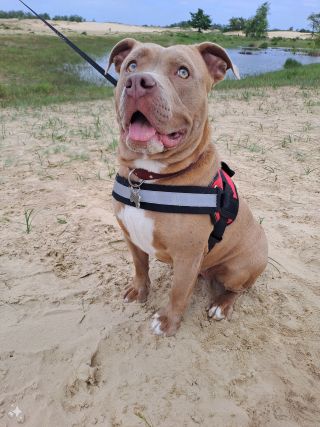Leadership
9 Lessons on Effective Leadership from Man’s Best Friend
What my furry companion taught me about nurturing an effective team.
Posted June 18, 2024 Reviewed by Abigail Fagan
Key points
- Dogs can teach us powerful leadership lessons like positive reinforcement and emotional intelligence.
- Training a dog teaches patience and consistency, which is essential for effective leadership.
- Balancing discipline and affection with dogs mirrors how leaders boost morale and motivation.

When we welcomed Toffie, an 8-month-old American Pocket Bully, into our lives, little did we know this decision would be a crash course in effective leadership! Training, nurturing, and bonding with Toffie revealed that successful leadership principles are rooted in the same values that guide our relationships with our canine companions. Here are nine unexpected lessons my dog (unintentionally) taught me about nurturing an effective team:
1. Patience and Consistency Are Pawesome Ingredients
Remember those early house-training days? Endless puddles and chewed-up slippers tested my patience. But just like potty training, leading a group of skilled professionals requires consistent reinforcement, clarity, and persistent patience. Effective leaders understand that growth is a process, offering support and guidance as team members develop. Leading a team necessitates a consistent vision and unwavering commitment to growth.
2. Building Trust and Loyalty: A Bond Built With Treats
Your dog wouldn’t follow you on adventures or shower you with slobbery kisses without complete trust. Similarly, building trust and loyalty within your team is crucial. Trust and loyalty are the cornerstones of any successful relationship. Toffie’s unconditional love reminded me that earning trust and fostering loyalty requires time, effort, and genuine investment in the wellbeing of those you lead. Just as I provided Toffie with a safe, nurturing environment, leaders must create a space where team members feel valued, supported, and empowered.
3. Speak Human, Not Dog: The Power of Clear Communication
Imagine trying to teach your dog to "sit" with a jumble of confusing commands and gestures. Not sure that would be helpful! Clear communication is thus crucial. Whether it be through verbal cues, body language, or treats, Toffie taught me the importance of conveying expectations and instructions with the utmost clarity. As a leader, it’s important to articulate your vision, communicate expectations, and provide feedback clearly. Regular check-ins and clear expectations ensure everyone is on the same page — achieving goals together.
4. Reward and Recognize Positive Behaviours: High Fives for Every Fetch
One powerful lesson I learned from Toffie was the impact of positive reinforcement. Whether it was mastering a new trick or simply navigating our way back home through a new route without issues, celebrating Toffie's small victories was crucial to maintaining her enthusiasm and motivation. Just as rewarding desirable behavior with treats and praise motivated Toffie to repeat those actions, recognizing and rewarding the achievements of team members fosters a culture of continuous improvement and desired outcomes. A simple "thank you" or a public shout-out reinforces desired behaviors and keeps morale high.
5. Adaptability: When Life Throws You a Curveball (or a Frisbee)
Dogs are remarkably adaptable creatures. They can adjust to new environments, routines, and challenges with remarkable resilience — if the right support is provided. We got Toffie as an 8-month-old pup who spent most of her life in a kennel and could pretty much do whatever she wanted within the confines of those four walls. When we brought her home, new rules, new environments and new routines were quite challenging for her. But in time, she settled in! Toffie's ability to navigate changes with ease served as a powerful reminder that effective leaders must embrace adaptability. In today's ever-evolving business landscape, the ability to pivot, adjust strategies, and navigate unfamiliar terrain is crucial for success.
6. Lead by Example: Actions Speak Louder Than Woofs
Dogs are masters at reading body language. A stressed owner translates to a stressed pup. Toffie's loyalty and eagerness to please stemmed from my commitment to leading by example. When I wanted her to be calm, I stayed calm and used a soothing tone. Similarly, effective leaders must embody the values, behaviors, and actions they expect from their team to inspire them to follow. Your actions set the tone and inspire others.
7. Every Dog Has Its Day: Unleashing Individual Strengths
I’ve had many dogs and can tell you that no two dogs are alike. My Jack Russell (Mr. Moffin) craved constant playtime, whilst my Pugs preferred a leisurely stroll and long naps. Mr. Moffin was a fast learner, eager to please, athletic, and protective. The Pugs, well, they had the ability to sleep 21 hours a day and snore so loud the neighbours would complain. Different dogs have different strengths. Great leaders recognize that team members possess unique strengths and create environments where these strengths are used optimally. Tailoring your approach to leverage their talents fosters a highly committed and performing team.

8. Balancing Unconditional Love and Discipline Unleashes Potential
Training Toffie required a delicate balance of discipline and affection. Too much discipline risked breaking her spirit; too much affection could reinforce undesirable behaviors. Similarly, effective leaders must strike a balance between holding their team accountable and providing positive reinforcement, creating an environment conducive to growth and success. Further, a dog thrives on affection and consistency and feels secure with a loving owner. Leaders who cultivate a culture of appreciation and respect create an environment where individuals feel valued. This sense of belonging fosters engagement and empowers team members to contribute their best selves.
9. Empathy: Walking a Mile in Your Dog's (or Team Member's) Paws
Have you ever tried to understand why your dog is barking incessantly? Maybe a pesky squirrel or a stranger at the door has them on high alert. By attuning myself to her needs and unique quirks, I was able to understand what she wanted and thus could forge a deeper connection and a stronger bond. Similarly, effective leaders must cultivate empathy and actively listen to really understand their team members' concerns, perspectives, and aspirations so that they can tailor their approach to meet individual needs.
Conclusion
Reflecting on my journey with Toffie, I realized leadership isn’t about barking orders or wielding a leash. It’s about building trust, fostering collaboration, and celebrating achievements. The next time you look into your dog's loyal eyes, remember — they might just be your next leadership guru. Now, go forth, unleash your inner leader, and build a team as strong and loyal as your furry best friend!




